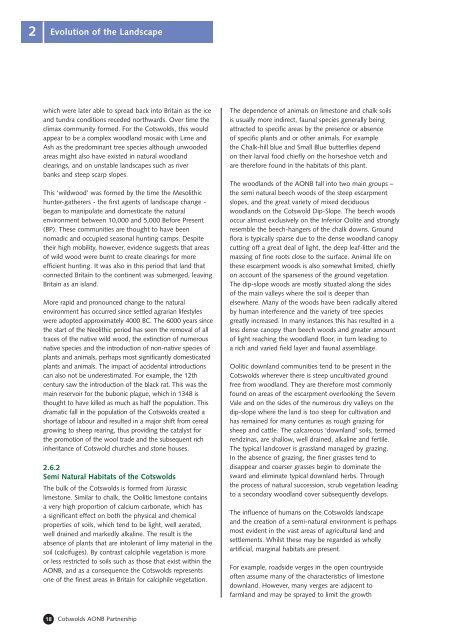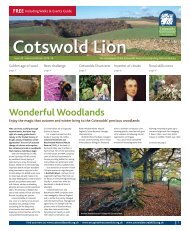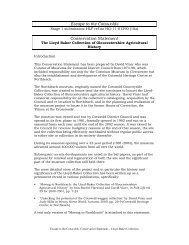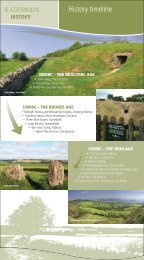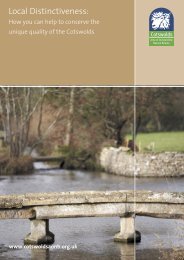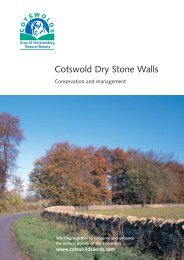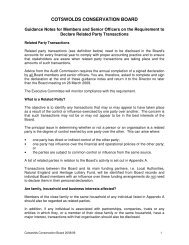AONB LCAR S1 P1-10 FINAL - the Cotswolds Area of Outstanding ...
AONB LCAR S1 P1-10 FINAL - the Cotswolds Area of Outstanding ...
AONB LCAR S1 P1-10 FINAL - the Cotswolds Area of Outstanding ...
Create successful ePaper yourself
Turn your PDF publications into a flip-book with our unique Google optimized e-Paper software.
2 Evolution <strong>of</strong> <strong>the</strong> Landscape<br />
which were later able to spread back into Britain as <strong>the</strong> ice<br />
and tundra conditions receded northwards. Over time <strong>the</strong><br />
climax community formed. For <strong>the</strong> <strong>Cotswolds</strong>, this would<br />
appear to be a complex woodland mosaic with Lime and<br />
Ash as <strong>the</strong> predominant tree species although unwooded<br />
areas might also have existed in natural woodland<br />
clearings, and on unstable landscapes such as river<br />
banks and steep scarp slopes.<br />
This ‘wildwood’ was formed by <strong>the</strong> time <strong>the</strong> Mesolithic<br />
hunter-ga<strong>the</strong>rers - <strong>the</strong> first agents <strong>of</strong> landscape change -<br />
began to manipulate and domesticate <strong>the</strong> natural<br />
environment between <strong>10</strong>,000 and 5,000 Before Present<br />
(BP). These communities are thought to have been<br />
nomadic and occupied seasonal hunting camps. Despite<br />
<strong>the</strong>ir high mobility, however, evidence suggests that areas<br />
<strong>of</strong> wild wood were burnt to create clearings for more<br />
efficient hunting. It was also in this period that land that<br />
connected Britain to <strong>the</strong> continent was submerged, leaving<br />
Britain as an island.<br />
More rapid and pronounced change to <strong>the</strong> natural<br />
environment has occurred since settled agrarian lifestyles<br />
were adopted approximately 4000 BC. The 6000 years since<br />
<strong>the</strong> start <strong>of</strong> <strong>the</strong> Neolithic period has seen <strong>the</strong> removal <strong>of</strong> all<br />
traces <strong>of</strong> <strong>the</strong> native wild wood, <strong>the</strong> extinction <strong>of</strong> numerous<br />
native species and <strong>the</strong> introduction <strong>of</strong> non-native species <strong>of</strong><br />
plants and animals, perhaps most significantly domesticated<br />
plants and animals. The impact <strong>of</strong> accidental introductions<br />
can also not be underestimated. For example, <strong>the</strong> 12th<br />
century saw <strong>the</strong> introduction <strong>of</strong> <strong>the</strong> black rat. This was <strong>the</strong><br />
main reservoir for <strong>the</strong> bubonic plague, which in 1348 is<br />
thought to have killed as much as half <strong>the</strong> population. This<br />
dramatic fall in <strong>the</strong> population <strong>of</strong> <strong>the</strong> <strong>Cotswolds</strong> created a<br />
shortage <strong>of</strong> labour and resulted in a major shift from cereal<br />
growing to sheep rearing, thus providing <strong>the</strong> catalyst for<br />
<strong>the</strong> promotion <strong>of</strong> <strong>the</strong> wool trade and <strong>the</strong> subsequent rich<br />
inheritance <strong>of</strong> Cotswold churches and stone houses.<br />
2.6.2<br />
Semi Natural Habitats <strong>of</strong> <strong>the</strong> <strong>Cotswolds</strong><br />
The bulk <strong>of</strong> <strong>the</strong> <strong>Cotswolds</strong> is formed from Jurassic<br />
limestone. Similar to chalk, <strong>the</strong> Oolitic limestone contains<br />
a very high proportion <strong>of</strong> calcium carbonate, which has<br />
a significant effect on both <strong>the</strong> physical and chemical<br />
properties <strong>of</strong> soils, which tend to be light, well aerated,<br />
well drained and markedly alkaline. The result is <strong>the</strong><br />
absence <strong>of</strong> plants that are intolerant <strong>of</strong> limy material in <strong>the</strong><br />
soil (calcifuges). By contrast calciphile vegetation is more<br />
or less restricted to soils such as those that exist within <strong>the</strong><br />
<strong>AONB</strong>, and as a consequence <strong>the</strong> <strong>Cotswolds</strong> represents<br />
one <strong>of</strong> <strong>the</strong> finest areas in Britain for calciphile vegetation.<br />
18<br />
<strong>Cotswolds</strong> <strong>AONB</strong> Partnership<br />
The dependence <strong>of</strong> animals on limestone and chalk soils<br />
is usually more indirect, faunal species generally being<br />
attracted to specific areas by <strong>the</strong> presence or absence<br />
<strong>of</strong> specific plants and or o<strong>the</strong>r animals. For example<br />
<strong>the</strong> Chalk-hill blue and Small Blue butterflies depend<br />
on <strong>the</strong>ir larval food chiefly on <strong>the</strong> horseshoe vetch and<br />
are <strong>the</strong>refore found in <strong>the</strong> habitats <strong>of</strong> this plant.<br />
The woodlands <strong>of</strong> <strong>the</strong> <strong>AONB</strong> fall into two main groups –<br />
<strong>the</strong> semi natural beech woods <strong>of</strong> <strong>the</strong> steep escarpment<br />
slopes, and <strong>the</strong> great variety <strong>of</strong> mixed deciduous<br />
woodlands on <strong>the</strong> Cotswold Dip-Slope. The beech woods<br />
occur almost exclusively on <strong>the</strong> Inferior Oolite and strongly<br />
resemble <strong>the</strong> beech-hangers <strong>of</strong> <strong>the</strong> chalk downs. Ground<br />
flora is typically sparse due to <strong>the</strong> dense woodland canopy<br />
cutting <strong>of</strong>f a great deal <strong>of</strong> light, <strong>the</strong> deep leaf-litter and <strong>the</strong><br />
massing <strong>of</strong> fine roots close to <strong>the</strong> surface. Animal life on<br />
<strong>the</strong>se escarpment woods is also somewhat limited, chiefly<br />
on account <strong>of</strong> <strong>the</strong> sparseness <strong>of</strong> <strong>the</strong> ground vegetation.<br />
The dip-slope woods are mostly situated along <strong>the</strong> sides<br />
<strong>of</strong> <strong>the</strong> main valleys where <strong>the</strong> soil is deeper than<br />
elsewhere. Many <strong>of</strong> <strong>the</strong> woods have been radically altered<br />
by human interference and <strong>the</strong> variety <strong>of</strong> tree species<br />
greatly increased. In many instances this has resulted in a<br />
less dense canopy than beech woods and greater amount<br />
<strong>of</strong> light reaching <strong>the</strong> woodland floor, in turn leading to<br />
a rich and varied field layer and faunal assemblage.<br />
Oolitic downland communities tend to be present in <strong>the</strong><br />
<strong>Cotswolds</strong> wherever <strong>the</strong>re is steep uncultivated ground<br />
free from woodland. They are <strong>the</strong>refore most commonly<br />
found on areas <strong>of</strong> <strong>the</strong> escarpment overlooking <strong>the</strong> Severn<br />
Vale and on <strong>the</strong> sides <strong>of</strong> <strong>the</strong> numerous dry valleys on <strong>the</strong><br />
dip-slope where <strong>the</strong> land is too steep for cultivation and<br />
has remained for many centuries as rough grazing for<br />
sheep and cattle. The calcareous ‘downland’ soils, termed<br />
rendzinas, are shallow, well drained, alkaline and fertile.<br />
The typical landcover is grassland managed by grazing.<br />
In <strong>the</strong> absence <strong>of</strong> grazing, <strong>the</strong> finer grasses tend to<br />
disappear and coarser grasses begin to dominate <strong>the</strong><br />
sward and eliminate typical downland herbs. Through<br />
<strong>the</strong> process <strong>of</strong> natural succession, scrub vegetation leading<br />
to a secondary woodland cover subsequently develops.<br />
The influence <strong>of</strong> humans on <strong>the</strong> <strong>Cotswolds</strong> landscape<br />
and <strong>the</strong> creation <strong>of</strong> a semi-natural environment is perhaps<br />
most evident in <strong>the</strong> vast areas <strong>of</strong> agricultural land and<br />
settlements. Whilst <strong>the</strong>se may be regarded as wholly<br />
artificial, marginal habitats are present.<br />
For example, roadside verges in <strong>the</strong> open countryside<br />
<strong>of</strong>ten assume many <strong>of</strong> <strong>the</strong> characteristics <strong>of</strong> limestone<br />
downland. However, many verges are adjacent to<br />
farmland and may be sprayed to limit <strong>the</strong> growth


